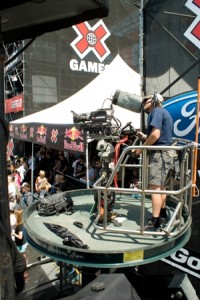13Jun/12Off
ESPN Gears Up for 3D X Games
 A DAUNTING SET OF VENUES
A DAUNTING SET OF VENUESWhether they employ a pair of HDTV broadcast cameras on a T-bracket, or a “beam splitter,” each 3D camera is a complex marriage of optics and electronics. In the same vein, 3D cameras are less forgiving of fast pans and cuts than their 2D cousins are. “Shooting in 3D requires more finesse and care than 2D does,” Orlins tells TV Technology.
PROVEN PRODUCTION SETUP
Thanks to their pioneering work in live 3D sports coverage, ESPN has become a veteran in shooting such events. As a result, the network knows what works. In this case, it is the same production setup that they used so successfully in Aspen for the Winter X Games.
Thanks to their pioneering work in live 3D sports coverage, ESPN has become a veteran in shooting such events. As a result, the network knows what works. In this case, it is the same production setup that they used so successfully in Aspen for the Winter X Games.
STILL NEW AND DIFFERENT
Two years after the launch of its ESPN 3D channel, ESPN has nearly 200 3D events to its credit. But this doesn’t mean that 3D production has become predictable, says Phil Orlins.
Two years after the launch of its ESPN 3D channel, ESPN has nearly 200 3D events to its credit. But this doesn’t mean that 3D production has become predictable, says Phil Orlins.
“Yes, we have learned a lot about 3D’s nature; how it doesn’t tolerate quick cuts and how you have to ‘layer’ your shots to optimize the depth of field,” Orlins explains. “But the experience we have gained is constantly being offset by the new things that we are always trying. I mean, two years ago, we didn’t have RF 3D handhelds or 3D FlyCams. But today, we’re doing it all in 3D.”
This said, ESPN’s Summer X Games coverage will make clear just how much this network has learned about 3D live production. This is why ESPN will be shooting 3D to create a realistic viewing experience—as if the viewer was actually on-site—rather than an “in-your-face” 3D circus. The network has become so comfortable with 3D that it has learned to use this production approach to its best story-telling advantage; rather than for 3D’s “freak show” value.
See the full story here: http://www.tvtechnology.com/article/espn-gears-up-for-d-x-games/213872